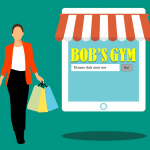Wellness businesses will face yet more demands on their online marketing budgets in 2013. This guide helps you invest time and money in what works instead of chasing mythical silver bullets.
1) Multi-device
Before her retirement, my mother-in-law worked in a municipal water utility where she wrote out water bills in a small Mississippi town, by hand, with a ballpoint pen.
Today, she actively uses her iPhone, Kindle, iPad, and a Windows PC. The phone’s for calls, pictures and texting. The Kindle’s for reading on the road. The iPad’s for games, and the desktop PC’s where she does online banking and keeps the family books on Quicken.
If she wants to find out whether her senior aquatics class is going to meet during the holidays, she might call you if she’s walking through Kroger, look up your website on her mobile or iPad if she’s out of town, or visit your website on Windows PC if she’s at home.
Your health and wellness customers are a lot like my mother-in-law. They will increasingly own multiple devices that they use for different purposes at different times.
The point: since you can’t know when your customers are going to use mobile, tablet, laptop or desktop, keep your website design simple and streamlined. Figure out the most popular information – hours, directions, appointments, whatever – and use simple, streamlined, highly visible navigation that works well on a tiny screen or a big monitor.
2) Park your stereotypes
Did I mention that my mother-in-law is seventy-one? Shame on you if you’re surprised that someone her age is so comfortable with technology.
Practically everyone assumes that older adults don’t “get” technology – that they’re afraid of it, unable to master it, or just not interested. Wrong on all three counts.
About 80% of folks in their 60s use the Internet, and most of those use it daily. Only when we look at adults over 75 do we see a sharp difference in Internet usage; only 30% of this group uses the Internet.
What does tend to vary by generation is which tools are primary, and how and when each tool is used.
For example, recent data from the Pew Internet Project, AARP, Accenture, eMarketer.com, the U.S. Census Bureau, Nielsen, Forrester and others indicates that:
- Gen X (people in their 30s/40s) and Gen Y aka Millenials (teens and 20s) are most likely to use tablets and social media sites
- Email usage is highest among Boomers (50s/60s) while chat is more common among Gen X’ers
- Mobile usage is equally high among Gen X, Gen Y, older Boomers and folks in their late sixties/early 70s
- Older mobile users tend to share jokes and phones while younger users tend to text more
The point: Technology has to be part of the plan for every single wellness business. The only caveat is that if you’re working with people 75+, your plan needs to include substantial assistance to help them effectively use the tool.
3) Mobile PRN
Sixty percent of the hundreds of thousands of apps in the Apple and Android stores have never been downloaded even once. Only about 2000 apps are routinely downloaded in any significant number. And of all the apps that do get downloaded, only about 20% get opened more than once.
Like those odds? I don’t, and that’s why mobile apps continue to be a fad that most wellness businesses would do well to ignore.
First, consider your location. While half or more of the mobile users in the U.S., Canada, Australia, Japan, Korea, Hong Kong and some European countries have smartphones, smartphone usage is dramatically lower in Brazil, India and China as well as Italy, Spain, and Mexico.
Second, many mobile apps for wellness businesses exist solely as a bandaid needed to treat poor website design. For example, customers shouldn’t need to download an app just to check your hours. Hours ought to be immediately and obviously accessible on your (streamlined) website.
Third, many mobile apps that are intended to act as food and activity trackers, coaches, condition monitors or similar health and wellness aids are nothing more than the same old wheel, reinvented yet again. Before you pay a developer to develop one of these apps, ask yourself why you’re not simply using one of the numerous alternatives already available.
Fourth, ask yourself whether an app is even the right technology. One of the demonstrably most effective ways to interact with health and wellness clients is via text message – reminders, tips, check-ins, and so forth.
The point: Use mobile apps only on a PRN basis – “as needed.” Start with a customer experience goal that actually needs a solution, and choose the best tool to solve that problem. Don’t develop one just because everyone else is doing it.
4) Paid, owned, earned, borrowed media
2013 will no doubt bring yet more online platforms clamoring for your marketing time and dollars.
That means it’s even more critical that you understand the difference between paid, owned, earned and what we term “borrowed” media.
Owned media – a communication channel that your wellness business controls completely. The most common examples would be your website.
Paid media – a communication channel that you pay to feature your brand messages. Common online examples include Google AdWords and paying for a display ad sent to a local membership association’s email distribution list.
Earned media – communications initiated by your current or potential customers. Common examples include word of mouth and buzz.
Borrowed media – communication platforms controlled by others. The most obvious example is Facebook.
The point: Spend your time and effort on tools you own and control, and on facilitating communication around and about your business by customers. That’s where you’ll see the highest return on investment. Don’t build your marketing plan around borrowed media like Facebook, where the rules constantly change and you have no control.*
* For example, nearly everyone thinks – wrongly – that Facebook notifies all of your Facebook friends or everyone who “likes” you every time you post. Nope, each post is only delivered to a tiny fraction of your friends. No wonder you’re not seeing results, huh?
5) Email – still the killer app
All the noise around Facebook and Twitter has drowned out the one essential truth for wellness marketers: email is where it’s at.
Email generates more sales per marketing dollar, followed by Internet search. Even notoriously ineffective online display ads outperform social media marketing when it comes to actual revenue generation.
And if you’re thinking, “Well, at least my Facebook page sends customers to our site,”, the answer is probably not. In 2012, “social sales” – sales which start with a click-through from Facebook or Twitter, for example – are down by 25%!
The point: chasing likes on Facebook has no discernible connection to increasing sales or profits. Don’t waste an email marketing campaign encouraging people to “like” you! Use those marketing emails to drive loyalty and make offers.




